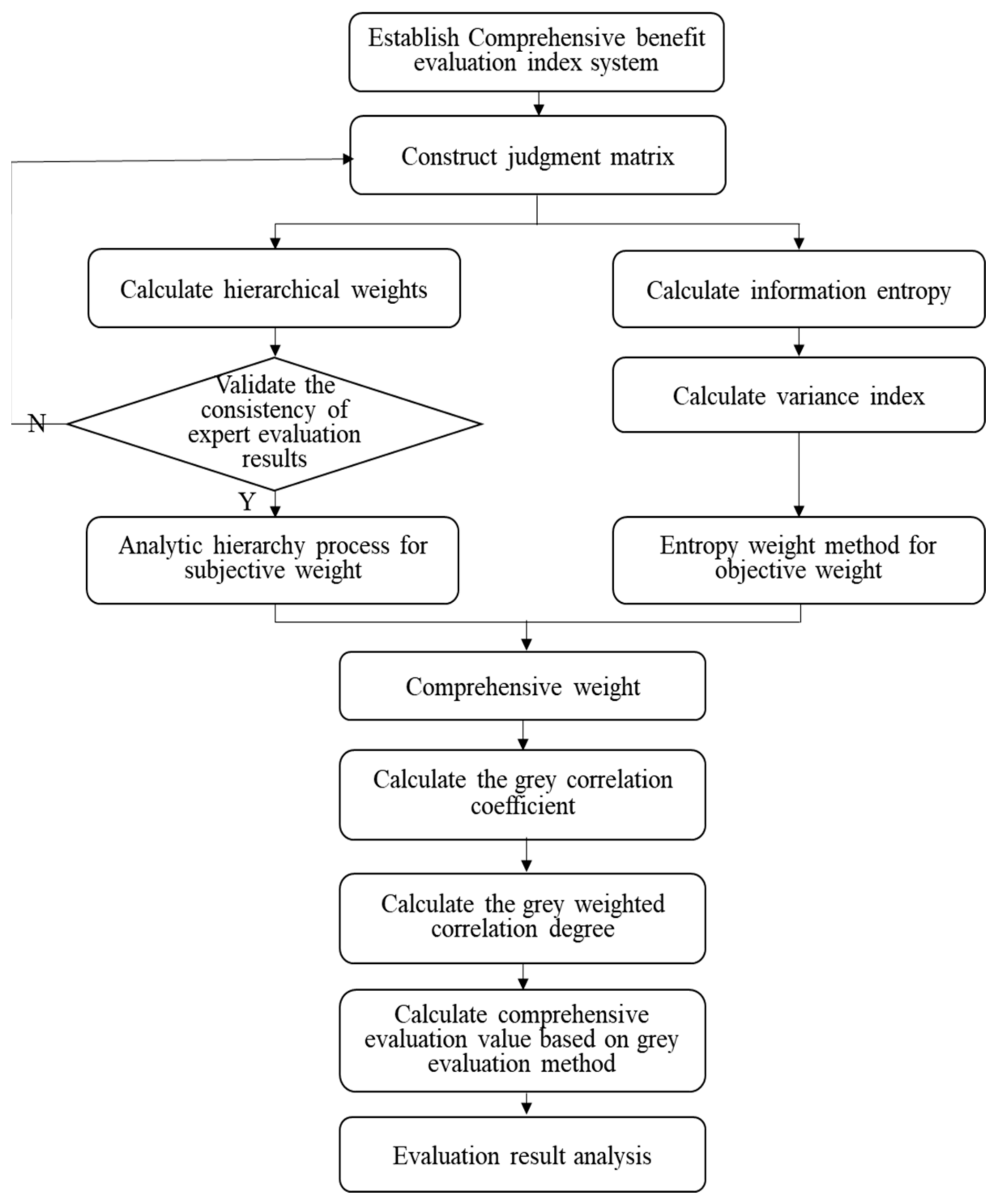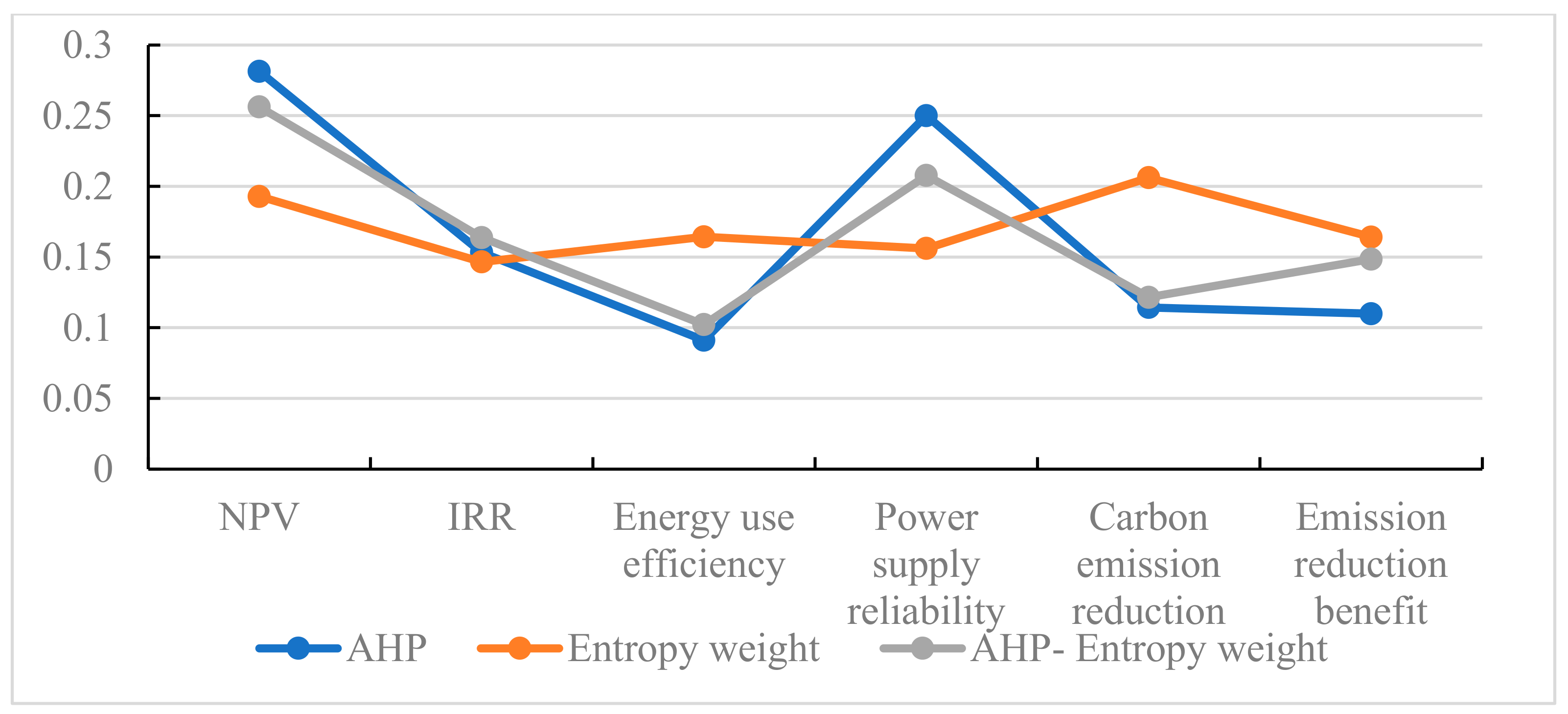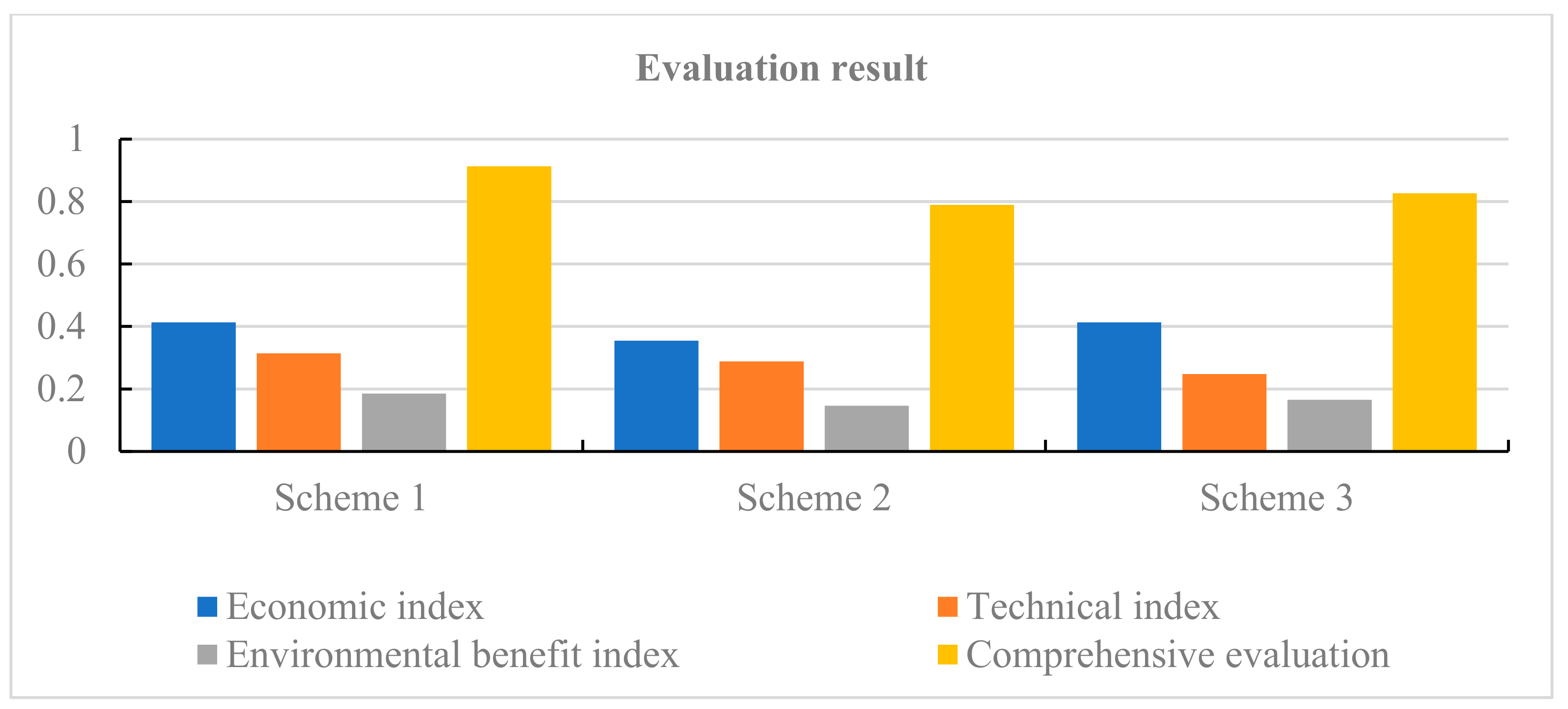Highway Microgrid Project Evaluation under Energy Transportation Integration
Abstract
1. Introduction
- (1)
- The first contribution is a new direction for the comprehensive benefit evaluation of a highway energy system, considering the integration of energy and transportation, and the effective evaluation of the complementary highway microgrid, considering the energy coupling characteristics of “Source-Network-Load-Storage”. This paper mainly synthesizes three benefit indicators: economic benefit, technical benefit, and environmental benefit. The economic benefit covers the net present value and the internal rate of return. The technical benefit includes energy use efficiency and power supply reliability. The environmental benefit contains carbon emission reduction and emission reduction benefit.
- (2)
- The second contribution is that the AHP–entropy weight method is put forward to ensure the weight between different standards. The AHP–entropy weight method is used to work out the weights, not only considering the experience of the evaluator, but also providing objectivity. Meanwhile, a grey comprehensive evaluation using grey relational degree is presented to achieve the comprehensive evaluation of the efficiency of the highway microgrid project.
2. Highway Microgrid Evaluation System
2.1. The Composition of the Index Evaluation System
2.2. Index Evaluation Connotation
2.2.1. Economic Index
- Routine maintenance cost
- 2.
- Slope maintenance cost
- 3.
- Dust removal maintenance cost
- 4.
- Noise penalty cost
- Microgrid sale income
- 2.
- Service income
- NPV
- 2.
- IRR
2.2.2. Technical Index
- Energy use efficiency [29]
- 2.
- Power supply reliability
2.2.3. Environmental Benefit Index
- Carbon emission reduction [30]
- 2.
- Emission reduction benefit
3. Highway Microgrid Comprehensive Evaluation Method
3.1. The Calculation Method of Weight
3.1.1. Analytic Hierarchy Process
3.1.2. Entropy Weight Method
3.1.3. Comprehensive Weight Calculation
3.2. Grey Comprehensive Evaluation Method
4. Case Study
4.1. Example Introduction
4.2. Comprehensive Benefit Evaluation
4.3. Evaluation Result Analysis
4.3.1. Comparison of Index Weight Assignment Methods
4.3.2. Comparison of Microgrid Planning Schemes
4.3.3. Comparison of Evaluation Results under Different Methods
5. Conclusions
- (1)
- In view of the lack of comprehensive evaluation of the “Source-Network-Load-Storage” microgrid scheme, the index system of a highway microgrid is developed in this paper. The index system suitable for the expressway microgrid is constructed from three aspects. The results yield an evaluation value of the planning scheme adopted in this paper of 0.9127, and the highway microgrid has good economic, technical, and environmental benefits, which provides a new idea for the construction of a highway microgrid under the integration of energy and transportation.
- (2)
- The use of the AHP–entropy weight method can not only make use of subjective experience, but also make use of objective facts, so as to avoid the evaluation deviation caused by the imperfect index system. The grey comprehensive evaluation method based on the AHP–entropy weight method is obtained and used to solve the problem that the fuzzy evaluation method can only evaluate the system containing model factors, but not the evaluation indexes with correlation.
Author Contributions
Funding
Institutional Review Board Statement
Informed Consent Statement
Data Availability Statement
Conflicts of Interest
References
- Ma, J.; Xu, H.L.; Ma, R.C. A review on the development of resilient highway energy system under the integration of energy and transportation. Power Syst. Technol. 2022, 38, 1–14. [Google Scholar]
- Yang, X.F.; Su, J. Overview on micro-grid technology. Proc. CSEE 2014, 34, 57–70. [Google Scholar]
- Jia, L.M.; Shi, R.F.; Ji, L. Road transportation and energy integration strategy in China. Strateg. Study CAE 2022, 24, 163–172. [Google Scholar] [CrossRef]
- Hu, H.T.; Zheng, Z.; He, Z.Y. The framework and key technologies of traffic energy internet. Proc. CSEE 2018, 38, 12–24. [Google Scholar]
- Poe, C.; Filosa, G. Alternative Uses of Highway Rights of Way: Accommodating Renewable Energy Technologies. Transp. Res. Rec. 2018, 2270, 23–30. [Google Scholar] [CrossRef]
- Soullam, K.; Yuhwa, L.; Hak-Ryong, M. Siting criteria and feasibility analysis for PV power generation projects using road facilities. Renew. Sustain. Energy Rev. 2018, 81, 3061–3069. [Google Scholar]
- Ge, S.Y.; Zhu, L.W.; Liu, H. Optimal deployment of electric vehicle charging stations on the highway based on dynamic traffic simulation. Trans. China Electrotech. Soc. 2018, 33, 2991–3001. [Google Scholar]
- Li, C.Z.; Wang, N.L.; Dou, X.X. Review and Prospect on the System Integration of Distributed Energy System With the Complementation of Multiple Energy Sources. Proc. CSEE 2023, 43, 7127–7150. [Google Scholar]
- Ren, H.B.; Gao, W.J.; Zhou, W.S. Multi- criteria evaluation for the optimal adoption of distributed residential energy systems in Japan. Energy Policy 2009, 37, 5484–5493. [Google Scholar] [CrossRef]
- Zhang, X.; Li, H.; Hu, Q.; Zhou, Q.; Shen, B.; Xiang, J. Comprehensive location evaluation of multi-station integration. Electr. Power Eng. Technol. 2022, 41, 53–59. [Google Scholar]
- Zou, X.; Zhang, H.; Lei, L.; Xu, Y.; Zheng, L.; Jiao, F. Research and Application of Significance Determination for Safety-Related Feedback Information Based on Analytic Hierarchy Process in Nuclear Power Plants. Power Eng. 2023, 44, 189–195. [Google Scholar]
- Han, Z.T.; Huang, Z.W.; Ge, S.Y. A comprehensive evaluation system of urban distribution network. Power Syst. Technol. 2012, 36, 95–99. [Google Scholar]
- Li, B.; Liu, Z.F.; Huang, L.J. Comprehensive evaluation benchmark study on line loss management of county power grids. Power Syst. Technol. 2016, 40, 3871–3879. [Google Scholar]
- Guo, H.Y.; Liu, J.S.; Cheng, H.Z. Comprehensive Evaluation of Grid-connected Distributed Generation Based on Fuzzy Mathematics and Combinated Weighting Method. Mod. Electr. Power 2017, 34, 14–19. [Google Scholar]
- Yang, H.; Han, W.; Zeng, T.; Wang, K. Failure Risk Assessment of the Power System transmission Line based on an Improved Entropy Method. Appl. Mech. Mater. 2013, 2490, 1514–1517. [Google Scholar] [CrossRef]
- Tian, H.; Zhao, L.; Guo, S. Comprehensive Benefit Evaluation of Power Grid Investment Considering Renewable Energy Development from the Perspective of Sustainability. Sustainability 2023, 15, 8299. [Google Scholar] [CrossRef]
- Qi, M.F.; Fu, Z.G.; Jing, Y. A comprehensive evaluation method of power plant units based on information entropy and principal component analysis. Proc. CSEE 2013, 33, 58–64. [Google Scholar]
- Shao, B.; Hu, Z.; Liu, D. Using Improved Principal Component Analysis to Explore Construction Accident Situations from the Multi-Dimensional Perspective: A Chinese Study. Int. J. Environ. Res. Public Health 2019, 16, 3476. [Google Scholar] [CrossRef]
- Zeng, B.; Li, Y.Z.; Liu, Z.Q. Comprehensive evaluation method for environmental benefits of smart distribution network based on TO-PCA. Power Syst. Technol. 2016, 40, 396–404. [Google Scholar]
- He, Y.X.; Dai, A.Y.; Yang, W.H. Identification and evaluation of risk in urban network planning based on fuzzy theory. Power Syst. Technol. 2010, 34, 127–132. [Google Scholar]
- Xie, H.; Teng, X.F.; Zhang, Y.J. Analysis of economic influence factors in wind-photovoltaic-storage microgrid. Autom. Electr. Power Syst. 2019, 43, 70–76. [Google Scholar]
- An, M.; Xiao, S.; Liu, B. Reliability evaluation of expressway energy self-reliance system considering time-varying factors. J. North China Electr. Power Univ. 2024, 51, 39–48. [Google Scholar]
- Meng, R.; Zhang, L.; Zang, H.; Jin, S. Evaluation of Environmental and Economic Integrated Benefits of Photovoltaic Poverty Alleviation Technology in the Sanjiangyuan Region of Qinghai Province. Sustainability 2021, 13, 13236. [Google Scholar] [CrossRef]
- Zhang, S.X. Evaluation method of park level integrated energy system for microgrid. Power Syst. Technol. 2018, 42, 2431–2439. [Google Scholar]
- Zhao, B.; Zhang, S.W.; Cao, S.X. Cleaning cycle determination and cost estimation for photovoltaic modules based on dust accumulating condition monitoring. Proc. CSEE 2019, 39, 4205–4213. [Google Scholar]
- Xu, Z.M.; Qu, H.W.; Wang, J.W. Dusty PV modules optimal cleaning cycle. Proc. CSEE 2018, 36, 1738–1742. [Google Scholar]
- Ge, S.Y.; Zhou, H.; Liu, H.; Sun, W.; Zhang, Q.; Chen, B. Considering the impact of vehicle accidents, freeway charging stations and service areas are coordinated planning. Proc. CSU-EPSA 2019, 31, 1–8. [Google Scholar]
- Pan, X.; Liu, K.; Wang, J.; Hu, Y.; Zhao, J. Capacity Allocation Method Based on Historical Data-Driven Search Algorithm for Integrated PV and Energy Storage Charging Station. Sustainability 2023, 15, 5480. [Google Scholar]
- Wang, B.; Zhao, W.W.; Lin, S.J. Integrated energy management of highway service area based on improved multi-objective quantum genetic algorithm. Power Syst. Technol. 2022, 46, 1742–1751. [Google Scholar]
- Tan, Y.; Xie, G.; Xiao, Y.; Luo, Y.; Xie, X.; Wen, M. Comprehensive Benefit Evaluation of Hybrid Pumped-Storage Power Stations Based on Improved Rank Correlation-Entropy Weight Method. Energies 2022, 15, 8414. [Google Scholar] [CrossRef]
- Jiang, L.Z.; Bie, Z.H.; Long, T. Development model and key technology of integrated energy and transportation system. Proc. CSEE 2022, 42, 1285–1301. [Google Scholar]
- Zhou, X.; Chen, C.; Chen, J.; Li, Y.; Lu, X.; Li, J.; Wang, Y. Evaluation Method of Synergy Degree for Comprehensive Benefits System of Hydropower Projects. Sustainability 2021, 13, 10770. [Google Scholar] [CrossRef]
- Zhang, T.; Zhu, T.; Gao, N.P. Optimization design and multi-criteria comprehensive evaluation method of combined cooling heating and power system. Proc. CSEE 2015, 35, 3706–3713. [Google Scholar]
- Pan, X.; Liu, H.; Huan, J.; Sui, Y.; Hong, H. Allocation Model of Carbon Emission Permits for the Electric Power Industry with a Combination Subjective and Objective Weighting Approach. Energies 2020, 13, 706. [Google Scholar] [CrossRef]
- Dong, F.G.; Zhang, Y.; Shang, M.M. Multi-criteria comprehensive evaluation of distributed energy system. Proc. CSEE 2016, 36, 3214–3223. [Google Scholar]
- Malek, A.; Ebrahimnejad, S.; Tavakkoli-Moghaddam, R. An Improved Hybrid Grey Relational Analysis Approach for Green Resilient Supply Chain Network Assessment. Sustainability 2017, 9, 1433. [Google Scholar] [CrossRef]
- Zeng, J.; Xu, D.D.; Guo, H.F. Renewable energy-oriented micro-grid power quality characteristic analysis and comprehensive evaluation. Power Syst. Prot. Control 2016, 44, 10–16. [Google Scholar]



| Overall Index | Primary Index | Secondary Index |
|---|---|---|
| comprehensive index evaluation system | Economic index | Net Present Value |
| Internal Rate of Return | ||
| Technical index | Energy use efficiency | |
| Power supply reliability | ||
| Environmental benefit index | Carbon emission reduction | |
| Emission reduction benefit |
| Scale | Value Basis |
|---|---|
| 1 | Both indicators are equally important |
| 3 | The former indicator is slightly more important than the latter indicator |
| 5 | The former indicator is significantly more important than the latter indicator |
| 7 | The former indicator is more important than the latter indicator |
| 9 | The former indicator is extremely more important than the latter indicator |
| 2, 4, 6, 8 | The importance of the two indicators lies between the above |
| Method | NPV | IRR | Energy Use Efficiency | Power Supply Reliability | Carbon Emission Reduction | Emission Reduction Benefit |
|---|---|---|---|---|---|---|
| AHP | 0.2814 | 0.1533 | 0.0911 | 0.25 | 0.1143 | 0.1099 |
| Entropy weight | 0.1929 | 0.1465 | 0.1643 | 0.1561 | 0.2061 | 0.1641 |
| AHP-Entropy weight | 0.2562 | 0.1638 | 0.1023 | 0.2077 | 0.1215 | 0.1485 |
| Evaluation Method | Scheme 1 | Scheme 2 | Scheme 3 | |||
|---|---|---|---|---|---|---|
| Score | Ranking | Score | Ranking | Score | Ranking | |
| Textual method | 0.9127 | 1 | 0.7891 | 3 | 0.8264 | 2 |
| Delphi method | 0.7821 | 1 | 0.5743 | 3 | 0.6347 | 2 |
| Fuzzy comprehensiveevaluation method | 0.8443 | 1 | 0.7578 | 2 | 0.6951 | 3 |
Disclaimer/Publisher’s Note: The statements, opinions and data contained in all publications are solely those of the individual author(s) and contributor(s) and not of MDPI and/or the editor(s). MDPI and/or the editor(s) disclaim responsibility for any injury to people or property resulting from any ideas, methods, instructions or products referred to in the content. |
© 2024 by the authors. Licensee MDPI, Basel, Switzerland. This article is an open access article distributed under the terms and conditions of the Creative Commons Attribution (CC BY) license (https://creativecommons.org/licenses/by/4.0/).
Share and Cite
Yao, L.; Fu, H.; Shao, M.; Yu, Z. Highway Microgrid Project Evaluation under Energy Transportation Integration. Appl. Sci. 2024, 14, 2707. https://doi.org/10.3390/app14072707
Yao L, Fu H, Shao M, Yu Z. Highway Microgrid Project Evaluation under Energy Transportation Integration. Applied Sciences. 2024; 14(7):2707. https://doi.org/10.3390/app14072707
Chicago/Turabian StyleYao, Lei, Hao Fu, Ming Shao, and Zuyao Yu. 2024. "Highway Microgrid Project Evaluation under Energy Transportation Integration" Applied Sciences 14, no. 7: 2707. https://doi.org/10.3390/app14072707
APA StyleYao, L., Fu, H., Shao, M., & Yu, Z. (2024). Highway Microgrid Project Evaluation under Energy Transportation Integration. Applied Sciences, 14(7), 2707. https://doi.org/10.3390/app14072707





